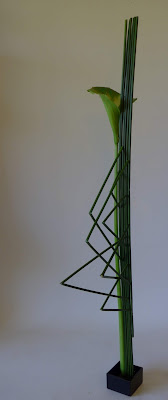
Hello all,
Spring in Melbourne is glorious and walking around in my garden
is pure delight. Here are just two examples of new spring growth.
They are my two weeping Japanese Maples with their brand new leaves. Below is a recent photo of one of the flower heads of my doryanthes Palmeri, which I had first photographed a month ago. It is only a little bit closer to flowering.
I was sick in bed on the recent class day, so I asked Lucy, my most senior student to take the classes for me. Lucy is amply qualified to teach and I trust her completely with my students. And the students' comments about her teaching were resoundingly positive.
For the senior students I set the theme 'Triangles' and instructed them to interpret this one word theme whichever way they wanted. The only thing I required from them was to produce a good piece of ikebana in the end. I had prepared the arrangement, below on the previous day before I fell ill. I used umbrella grass stems and crucifix orchids. Below mine are arrangements by some of the students. Interestingly, we all used umbrella grass. It is such a versatile material.
 |
| Vicky used umbrella grass and Green Goddess lily |
 |
| Nicole used umbrella grass stems and flower heads, which she cut into triangles |
 |
| Janette used umbrella grass stems, clivia and red straws. |
 |
| Jenny used gymea leaves and one arum lily |
 |
| Lucy used dowels to create this sculptural piece and one Sansevieria trifasciata 'Laurentii' leaf |
And here is just another arrangement using a strelitzia nicolai flower. With it I used Siberian dogwood which is just sprouting leaves and flowers. I keep trying to find different ways of using this very strong and heavy material.
Bye for now,
Emily









































